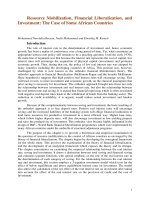Advances in Relationship Marketing Thought and Practice: The Influence of Social Network Theory
Bạn đang xem bản rút gọn của tài liệu. Xem và tải ngay bản đầy đủ của tài liệu tại đây (117.79 KB, 31 trang )
Advances in Relationship Marketing
Advances in Relationship Marketing
Thought and Practice: The Influence
Thought and Practice: The Influence
of Social Network Theory
of Social Network Theory
Presented at the
Presented at the
Networks and Complex Systems
Networks and Complex Systems
A talk series at Indiana University Bloomington
A talk series at Indiana University Bloomington
September 18, 2006
September 18, 2006
Constance Elise Porter, Ph.D.
Constance Elise Porter, Ph.D.
Assistant Professor of Marketing
Assistant Professor of Marketing
University of Notre Dame
University of Notre Dame
Marketing focuses on the exchange process,
Marketing focuses on the exchange process,
making it relational,
making it relational,
by definition.
by definition.
•
Relationship marketing is a dominant
Relationship marketing is a dominant
paradigm of marketing practice.
paradigm of marketing practice.
(Dwyer, Schurr and Oh
(Dwyer, Schurr and Oh
1987; Morgan and Hunt 1994)
1987; Morgan and Hunt 1994)
–
It emerged in the B2B arena because the number of relationships
It emerged in the B2B arena because the number of relationships
managed were smaller (e.g. B2B sales)
managed were smaller (e.g. B2B sales)
–
Is is now dominant in the B2C arena via due to technology-laden
Is is now dominant in the B2C arena via due to technology-laden
concepts such as “CRM and “One-to-One Marketing”
concepts such as “CRM and “One-to-One Marketing”
•
Marketing researchers and practitioners seek
Marketing researchers and practitioners seek
to understand relational behavior:
to understand relational behavior:
–
Between firms and customers/consumers (traditional)
Between firms and customers/consumers (traditional)
–
Among customers/Among business partners (emerging work in
Among customers/Among business partners (emerging work in
customer collaboration, customer/professional
customer collaboration, customer/professional
communities/knowledge networks)
communities/knowledge networks)
The fundamental premise of this
The fundamental premise of this
talk….
talk….
Because marketing is relational,
Because marketing is relational,
social network theory (SNT) helps to
social network theory (SNT) helps to
advance marketing theory and
advance marketing theory and
practice.
practice.
Discussion Topics
Discussion Topics
1.
1.
A Historical Perspective
A Historical Perspective
•
How does the marketing perspective compare to the
How does the marketing perspective compare to the
sociological perspective?
sociological perspective?
2.
2.
How has SNT advanced relationship marketing
How has SNT advanced relationship marketing
thought and practice?
thought and practice?
•
What are the three key perspectives of SNT that have
What are the three key perspectives of SNT that have
influence marketing theory and practice?
influence marketing theory and practice?
•
How have researchers used these perspectives to advance
How have researchers used these perspectives to advance
marketing theory and practice?
marketing theory and practice?
3.
3.
A Look at the Future
A Look at the Future
•
How do current trends reflect the importance of SNT to
How do current trends reflect the importance of SNT to
marketing thought and practice?
marketing thought and practice?
•
How could social network theory enhance my investigation
How could social network theory enhance my investigation
of relationship marketing in virtual communities?
of relationship marketing in virtual communities?
A Historical Perspective
A Historical Perspective
Marketers use basic SNT concepts, but
Marketers use basic SNT concepts, but
questions and methods differ.
questions and methods differ.
Points of Alignment:
Points of Alignment:
•
Networks are socially connected actors
Networks are socially connected actors
(more than 2)
(more than 2)
•
Resources (e.g. information) are transferred among actors in
Resources (e.g. information) are transferred among actors in
a network
a network
•
There is a flow of resources within the network
There is a flow of resources within the network
Points of Difference:
Points of Difference:
•
SN theorist (and early marketing researchers) seek to
SN theorist (and early marketing researchers) seek to
describe individual actors and their relations/patterns of
describe individual actors and their relations/patterns of
connections
connections
–
Sociometric theory….Whole Network…Software tools (e.g. UCINET and KRACKplot)
Sociometric theory….Whole Network…Software tools (e.g. UCINET and KRACKplot)
•
Contemporary marketing researchers tend to examine specific
Contemporary marketing researchers tend to examine specific
marketing outcomes related to influence in social networks
marketing outcomes related to influence in social networks
–
Psychometric theory…Sample/Ego-centered…SPSS/SAS for regression techniques
Psychometric theory…Sample/Ego-centered…SPSS/SAS for regression techniques
Centrality also is important to both, but
Centrality also is important to both, but
marketers apply the concept differently.
marketers apply the concept differently.
Social Network Theorists
Social Network Theorists
•
“
“
Between-ness”
Between-ness”
–
The frequency with which an
The frequency with which an
actor is intermediary to other
actor is intermediary to other
nodes and controls the flow of
nodes and controls the flow of
resources
resources
•
Degree
Degree
–
The number of actors with
The number of actors with
whom an individual has a
whom an individual has a
direct connection
direct connection
Marketing Applications
Marketing Applications
•
Word of Mouth
Word of Mouth
–
Actors:
Actors:
opinion leaders,
opinion leaders,
gatekeepers/market mavens and
gatekeepers/market mavens and
followers
followers
•
Those who are likely to
Those who are likely to
influence
influence
others
others
•
Those who know and provide information
Those who know and provide information
but have no
but have no
influence
influence
•
Those who are likely to be
Those who are likely to be
influenced
influenced
via
via
passive or active solicitation of info
passive or active solicitation of info
–
Profile of actors
Profile of actors
•
Knowledgeable, involved, confident, active
Knowledgeable, involved, confident, active
–
Content
Content
•
Valence (positive or negative)
Valence (positive or negative)
•
Product attributes (new, important,
Product attributes (new, important,
distinctive, risky)
distinctive, risky)
•
Diffusion of Innovations (borrowed from
Diffusion of Innovations (borrowed from
Rogers) & New product adoption
Rogers) & New product adoption
Finally, marketers tend to take a
Finally, marketers tend to take a
relational perspective of networks.
relational perspective of networks.
(exception: Hopkins, Henderson and Iacobucci 1995)
(exception: Hopkins, Henderson and Iacobucci 1995)
Relational Perspective
Relational Perspective
•
focuses on the extent to which
focuses on the extent to which
all actors are interconnected
all actors are interconnected
–
Relations
Relations
(strands):
(strands):
content, direction and and strength
content, direction and and strength
–
Ties:
Ties:
Weak/Strong based on frequency of
Weak/Strong based on frequency of
social contact, importance of
social contact, importance of
relation
relation
–
Multiplexity
Multiplexity
the number of relations in a tie
the number of relations in a tie
Positional Perspective
Positional Perspective
•
focuses on equivalence of
focuses on equivalence of
actors in a subgroup
actors in a subgroup
based on social strata
based on social strata
–
Does not assume social
Does not assume social
relations
relations
–
Assumes structural
Assumes structural
equivalence
equivalence
How has SNT advanced
How has SNT advanced
relationship marketing
relationship marketing
thought and practice?
thought and practice?
The Most Popular SNT
The Most Popular SNT
perspectives used in Marketing
perspectives used in Marketing
•
The Structural Perspective
The Structural Perspective
•
The Socio-Economic Perspective
The Socio-Economic Perspective
•
The Socio-Cognitive Perspective
The Socio-Cognitive Perspective
The Structural Perspective:
The Structural Perspective:
“
“
The structure of relations drives marketing outcomes.”
The structure of relations drives marketing outcomes.”
•
Typical Research Questions:
Typical Research Questions:
–
How do relationships influence consumer choice of
How do relationships influence consumer choice of
brands, referral sources and information-seeking
brands, referral sources and information-seeking
strategies?
strategies?
–
How do social networks influence behavior and outcomes
How do social networks influence behavior and outcomes
in an industrial marketing context
in an industrial marketing context
•
Typical Methods
Typical Methods
–
Interviews and surveys (consumer marketing)
Interviews and surveys (consumer marketing)
–
Case studies, interviews, document analysis and other
Case studies, interviews, document analysis and other
qualitative methods
qualitative methods
Typical Variables Examined within The
Typical Variables Examined within The
Structural Perspective
Structural Perspective
Social
Social
Structure
Structure
•
Interpersonal Relations
Interpersonal Relations
•
Strength of Tie
Strength of Tie
•
Membership in a subgroup for one good
Membership in a subgroup for one good
•
Centrality
Centrality
•
Cosmopolitaness (out-network ties)
Cosmopolitaness (out-network ties)
Outcomes
Outcomes
•
Brand Congruence
Brand Congruence
•
Brand Congruency for Multiple Brands
Brand Congruency for Multiple Brands
•
Flow of Communication across subgroups
Flow of Communication across subgroups
•
Diffusion of Innovation
Diffusion of Innovation
•
Likelihood of Activation as a referral source
Likelihood of Activation as a referral source
•
Influence
Influence









